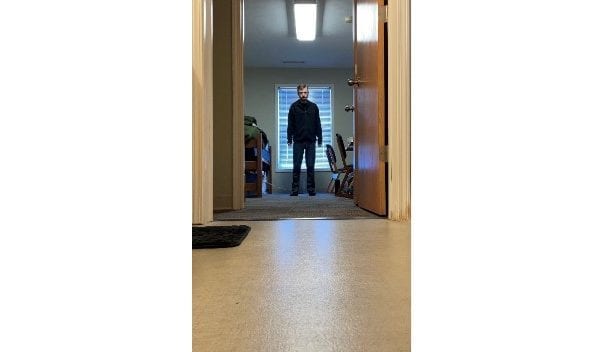Gierke Reviews: Why the Shining is Still Relevant Today
Photo Courtesy of Caleb Gierke
By Caleb Gierke
Stanley Kubrick’s The Shining(1980) is widely considered to be one of the classic horror films and I’m inclined to agree with them. It’s hard to find a horror film ranking without The Shining appearing somewhere in it. When I first saw The Shining in high school, it had built up such a reputation that I was genuinely afraid to watch it in class. The Shining doesn’t rely as much on the jump scare side of horror films, but instead works by seeping discomfort and fear into every orifice of your being. Kubrick does this through creating an atmosphere that never ceases to feel like something is off or that the stability of the hotel is a hair away from baring its fangs on the Torrance family.
The jarring strings of the score composed by Wendy Carlos and Rachel Elkind only add to this atmosphere as it assaults your ears to keep them on the edge of their seats. String instruments are the best friend to any horror film as the jarring sounds you can make with them can disorient the audience, but also impart the audience with a sense of discomfort or shock. Take Alfred Hitchcock’s Psycho(1960) and its iconic score with the audio assault of string instruments at the major moments of the film. It overwhelms our senses, which can lead us to being more vulnerable to the disturbing events transpiring on screen.
The events transpiring on screen definitely lend themselves to overwhelming the audience with all the uncomfortable events happening on screen. A lot of this can be attributed to Jack Nicholson’s performance as Jack Torrance. Nicholson imparts Jack Torrance with a menacing aura about him as he descends further into the hotel’s clutches. Jack is a very flawed individual and the combined influence of the isolation and the hotel transform him into a vessel to do the hotel’s building. Nicholson steals every scene he is in from the very beginning as he clues us into a sense of discomfort in Jack Torrance that the audience may not be able to put their finger on in the beginning. Each transition of time peels back the layers of discomfort that make up the mystique of Jack Torrance until he becomes the character from the iconic “Here’s Johnny” scene.
Now to address an element of the film that is somewhat harder to understand, that is the concept of the Shining. The Shining is a reference to a magic power of sorts that Danny and Dick Hallorran have that is largely unexplained or delved into in the film. The 2019 sequel film Doctor Sleep goes more in depth into how this power works, but the extent of its usage in The Shining is important, but not something you necessarily need to understand completely. The Shining, to me, reads as an adaptation of Stephen King’s book, but an adaptation that can exist as its own entity alongside King’s book. A lot of book adaptations fall into two categories: the straight adaptation or the more liberal adaptation that takes more creative opportunities to tell their story. Neither is necessarily better or worse than the other, but The Shining series fits nicely into both sides of this idea. The Shining falls more into the latter category, while Doctor Sleep falls more in line with the former.
Regardless of how you view either area, The Shining is absolutely worth a watch even if just to say you’ve seen it. It’s a classic for a reason and it still holds up to this day. It’s a fairly long film clocking in at around two and a half hours, but it is well worth it. The Shining was one of the films that made me want to write about films and to some extent make them, so it’s well worth the time commitment.
The Shining is currently not streaming on any service, but is available to rent/buy from most places where you can digitally rent or buy movies. The sequel film, Doctor Sleep is streaming on HBO Max. For other Stephen King films, there are the two It films that are both streaming on HBO Max. For other psychological horror films, there is Psycho on the TCM channel or Midsommar on Amazon Prime.





